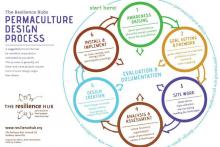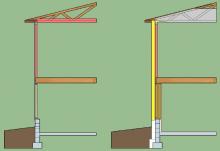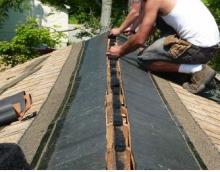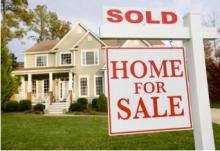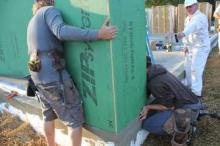Single family
Whole Property Retrofit: Redesigning Suburbia for an Uncertain Energy & Food Future
How do we turn the "problem" of suburbia into an enormous opportunity to create a set of resilient systems that can adapt to a changing world? Learn how a holistic design process and a whole-property retrofit in Maine has created a suburban model of living that requires significantly less time, money and energy to run while simultaneously enhancing the thermal comfort and well-being of the residents. This case study presents a transferable suite of findings on efficiency, renewables, integrated landscape elements, food production, transportation and “incremental deep energy retrofitting” which have weaned this eighty-year-old home completely off of fossil fuels.
Getting to Zero: Frameworks & Roadmap to help you achieve portfolio-wide performance improvements
The future of our planet and our profession depend on our ability to co-create collaboratively and achieve levels of synergy that transform our impact. Net Zero, the 2030 Challenge and LEED define performance targets. Yet, critical gaps remain between rising performance goals and the organizational capability to consistently achieve them. AIA 2030 data shows that 57% of gsf uses energy modeling, meaning 43% doesn’t. Most teams don’t know what the anticipated energy use is. Firms also report that LEED certified projects, which tend to have more commitment and higher levels of integration, have 24% lower pEUI than non-LEED projects, yet LEED still represents a small percentage of a firm’s portfolio. This session provides participants with frameworks and proven methodologies to transform their practice from “random acts of sustainability” to consistent capability based on cultural change, clearly articulated methodologies, truly integrative design and effective use of metrics to achieve continuous improvement.
Passive House Deep Energy Retrofits: Revitalizing Masonry Multifamily and Single Family Wood Frame Buildings
Michael Hindle and Matt Fine led a Passive House retrofit of three abandoned masonry apartment buildings on the Southeast side of Washington DC for low-income families. Designed to PHIUS+ standards, the renovation goal coupled with on-site renewables, and affordable housing tax credits, minimizes expenses for occupants - providing stability for resident families, while achieving nearly zero energy performance. The team designed and executed and external insulation strategy of I-joists and dense-pack fiberglass, with integrated window shading and airtightness. See the details, the processes and lessons learned.
Chris West bought a raised ranch house in Jericho, Vermont. Built in 1976 the house has standard 2x4 construction (16 oc) filled with fiberglass, single pane windows, and tuck under garage. In 2010 Chris took the Passive House training. Stuck with some earlier bad choices, and issues typical to every retrofit, see how he implemented Passive House methodology and calculations, to reduce the heating load of the house by 75%.
Building Science Puzzles
No matter how long you’ve been a building practitioner, you never stop encountering building science head-scratchers. Assemblies that you thought you had meticulously detailed may leak. Materials that you thought would last decades may show signs of pre-mature failure. Systems that seem like they should work (or have worked in the past) don’t. This workshop will teach you how to identify, diagnose and solve building science puzzles for a variety of building types, including residential, commercial and institutional, constructed using both traditional and modern methods. The presenters will share a series of case studies and invite the group to work together to identify the problems and propose solutions. Participants will also have an opportunity to present their own puzzles for group discussion.
What should be done with this house?
What will your existing house look like in the year 2050, if it’s to be part of the solution to the energy and environmental issues we face rather than a continuing part of the problem? What’s the pathway to get it there over time – how might a “phased retrofit” break down into logical, cost-effective steps? In this workshop, two long-time practitioners (and homeowners) will lead the group through a series of case studies to develop master plans for a range of houses. We’ll be looking not just at the homes and their existing internal systems, but also the various external systems and networks the homes participate in – social, transportation, legal and zoning, energy, natural, etc. Participants will be encouraged to submit their own or clients’ homes to the workshop leaders in advance to be prepared as case studies for group discussion. This workshop is open to homeowners and professionals both.
The Elephant in the Room: How to Affordably Increase the Energy Efficiency of Our Existing Housing Stock
The biggest hurdle for energy efficiency in the built environment today is how to improve the energy efficiency of our existing housing stock in an affordable manner. These three practitioners bring several years of experience to the fore. They have seen what works, what doesn't, and why. The session will review the best building practices of how to view, evaluate and perform an energy upgrade to a property. Average square foot costs on energy efficiency return will be discussed and what can be the expected energy reductions from certain projects. This session will focus on some of the easier energy-efficiency upgrades to be taken now and what to put off to employ our next generation. Evaluation of the existing available financial resources to be used for offsetting the owner costs and how they might be improved. Lastly, they will address when a project is beyond the scope of affordability and what telltale signs to look for.
Roofs: Research and Reality
To vent or not to vent? To insulate outboard or inboard? To provide details or just let contractors wing it? These are some of the questions two pros, who spend a good portion of their work days crawling around on roofs (of both wood framed and masonry buildings), will address. They will share case studies of roof failures; go over edge and penetration details that are so critical for long-term durability; discuss how to take advantage of opportunities to improve thermal performance; and share some of the latest geeky research, including how to do an unvented assembly without code-mandated spray foam. You’ll leave this session knowing what works, what doesn't, and how to juggle budgetary, design or building constraints to build durable, low-risk roofs.
The Value of R-Value and NPV of PV: Selling High Performance Homes in an Indifferent Market
The ideal client hires you to build a net zero energy home, or to complete a deep energy retrofit of their existing home. Two questions arise: How will the energy efficiency improvements impact the value of the construction loan? How much value is added to the home when it’s time to sell? These improvements change the value of the home and the perception of the home by potential buyers. It is up to the real estate agent, the appraiser, and the seller to understand and convey the potential value to a buyer. Learn from leading advocates, market participants, and analysts about the contributory value of energy efficiency improvements and energy producing technologies like solar and geothermal. Find out how these improvements increase homeowner equity and how they translate at the point of sale. Overcome the barriers preventing realizing value for efficiency in real estate transactions.
Passiv for the Masses
Climate change has made mainstream adoption of high-performance buildings a priority, and the Passivhaus standard provides a means to assess and drive the performance of these buildings. With 16 certified Passivhaus buildings between them, industry leaders Adam Cohen, Alan Gibson and Mathew Omalia will discuss their experiences designing and constructing a wide spectrum of building types, styles and scales that meet the Passivhaus standard. Adam Cohen will discuss techniques used to design, manufacture and construct Passivhaus buildings that cost the same or less than comparable code buildings. Alan Gibson will talk about simplifying construction systems and assemblies, and lessons learned about structure, moisture, air sealing, and air quality. Matt Omalia will explore how to integrate Passivhaus parameters into the design process to create a new canon of architectural design. The presenters will use case studies including: single and multi-family homes, schools, university residence halls, and community buildings.
Retrofit Like You Give a Sh*t: Inspiring Homeowners to Care about Efficiency
You care about the environment, climate change and sustainability. You want to do your part to make existing homes more energy efficient. But all your customers want are new kitchens, better bathrooms and big additions. What can you do? How can you help homeowners learn to value what they can’t see and begin to understand their house as a system? And equally important, how can you, on a limited budget, and in piecemeal fashion, move a house systematically toward greater energy efficiency? In this panel discussion, we’ll cover the following: educating homeowners about energy efficiency and the house as a system; making a long-term plan for energy upgrades over time; working incrementally to improve a home’s energy efficiency; and insuring that the way is clear for those who follow you.

